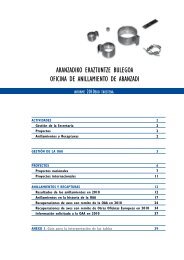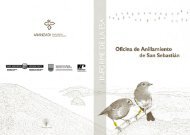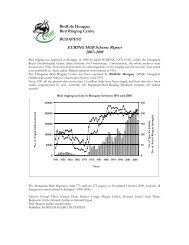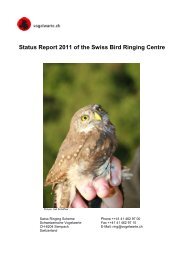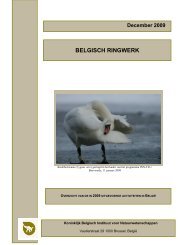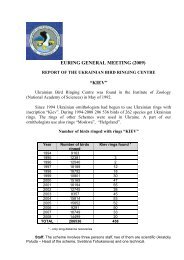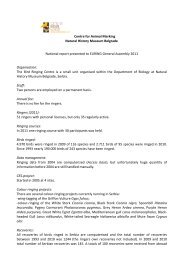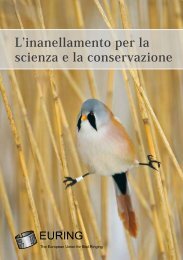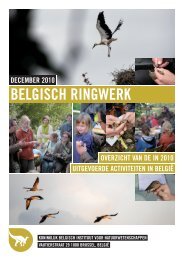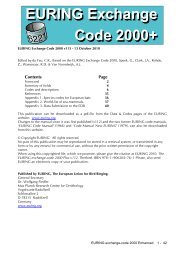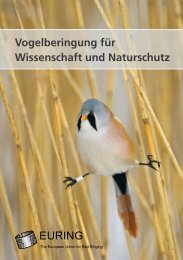here - The European Union for Bird Ringing
here - The European Union for Bird Ringing
here - The European Union for Bird Ringing
You also want an ePaper? Increase the reach of your titles
YUMPU automatically turns print PDFs into web optimized ePapers that Google loves.
3.4 Submission of local recaptures and ringing data<br />
Schemes have, traditionally, defined a lower distance or time limit <strong>for</strong> reporting live recaptures of<br />
birds. For example in Britain and Ireland movements of under 5 km <strong>for</strong> most species have not been<br />
recorded in the national recovery database. A list of schemes' practices is found at http://<br />
www.euring.org/data_and_codes/obtaining_data/recovery_definitions.htm Each scheme must<br />
determine its own lower limit <strong>for</strong> inclusion of live recaptures in their own database. <strong>The</strong> EDB will<br />
accept all records that schemes decide to include, whatever the lower distance limit may be.<br />
Schemes should submit all records <strong>for</strong> dead recoveries, even w<strong>here</strong> the ringing and recovery location<br />
are the same.<br />
<strong>The</strong> EDB is now able to accept ringing and recapture data <strong>for</strong> all birds, not only those which have<br />
been recaptured or recovered. If ringing records alone (without recovery or recapture data) are<br />
submitted, they must be submitted in 2000Plus code.<br />
3.5 Error checking and feedback to schemes<br />
Software written by Vidar Bakken is freely available from the schemes' private area of the EURING<br />
web site. This checks data files in 2000 code. Schemes submitting data in 2000 code should use this<br />
software to check data be<strong>for</strong>e submission.<br />
Data will be further validated at the EDB be<strong>for</strong>e loading into the main EDB database. Some errors can<br />
be corrected on loading. Typical errors in this category include an incorrect value <strong>for</strong> unknown data<br />
in a particular field, perhaps a U instead of a Z. Other errors cannot be corrected in this way - dates<br />
such as 31022007, <strong>for</strong> example.<br />
Feedback from this validation will be sent to schemes. First will be a general report with comments,<br />
w<strong>here</strong> appropriate, on each field. <strong>The</strong> second type of feedback will be a spreadsheet detailing records<br />
with particular errors. Schemes will be able to use this feedback to help improve the veracity of their<br />
own ringing recovery data sets. Erroneous records which need to be corrected be<strong>for</strong>e being loaded<br />
into the EDB need not be resubmitted until the scheme's next annual submission.<br />
3.6 File organisation<br />
Although the EURING Exchange Code 2000, manual is quite clear about the <strong>for</strong>mat of encounter<br />
records, the organisation of records within the file is not mentioned.<br />
As far as the EDB is concerned, the organisation of files is of little importance. Schemes are free to<br />
organise their submission data files in the way most convenient to them.<br />
Some methods which are used are these:<br />
1 All records in a single file, sorted by ring number and date of encounter. This is the most<br />
frequently used <strong>for</strong>mat and appears to be the most natural.<br />
2 All ringing encounter records in one file; all recovery encounters in a second file. Both<br />
files sorted by ring number order.<br />
3 One file <strong>for</strong> each species. Within the files, data are sorted by ring number and date.<br />
Files are generally submitted as an email attachment to the edb@bto.org. Large files are often zipped<br />
in order to ease transmission by email. It is also acceptable to submit data on CD through the postal<br />
system.<br />
3.7 Extinct schemes and old place codes<br />
Data from old schemes should normally retain the old scheme code. <strong>The</strong> only exception to this is<br />
w<strong>here</strong> a scheme continues, but under a new code. This can happen as a result of political changes. In<br />
these cases, the scheme must decide at which point the scheme code changes. It is possible, <strong>for</strong><br />
example, to change all historical records <strong>for</strong> the scheme to the new code, provided all birds with that<br />
old code were ringed with rings from the same ringing centre.<br />
Place codes also change according to various political considerations. Again, it is a matter <strong>for</strong> ringing<br />
schemes to determine whether their own records retain the old country and region codes, or whether<br />
they are converted to the current equivalent codes. However, <strong>for</strong> submission to the EDB, it is most<br />
helpful if country codes, at least, are converted to the latest version. Extraction and analysis of data<br />
from the EDB are made particularly difficult if any country codes are still in the original 1966 numeric<br />
codes.<br />
3.8 Unrecorded/unknown data<br />
<strong>The</strong> EURING code 2000 provided opportunities <strong>for</strong> recording variables which are vital <strong>for</strong> any bird<br />
encounter record - the ring number, <strong>for</strong> instance. However, some fields may be useful <strong>for</strong> many<br />
EURING exchange-code 2000 Enhanced 41 - 42



